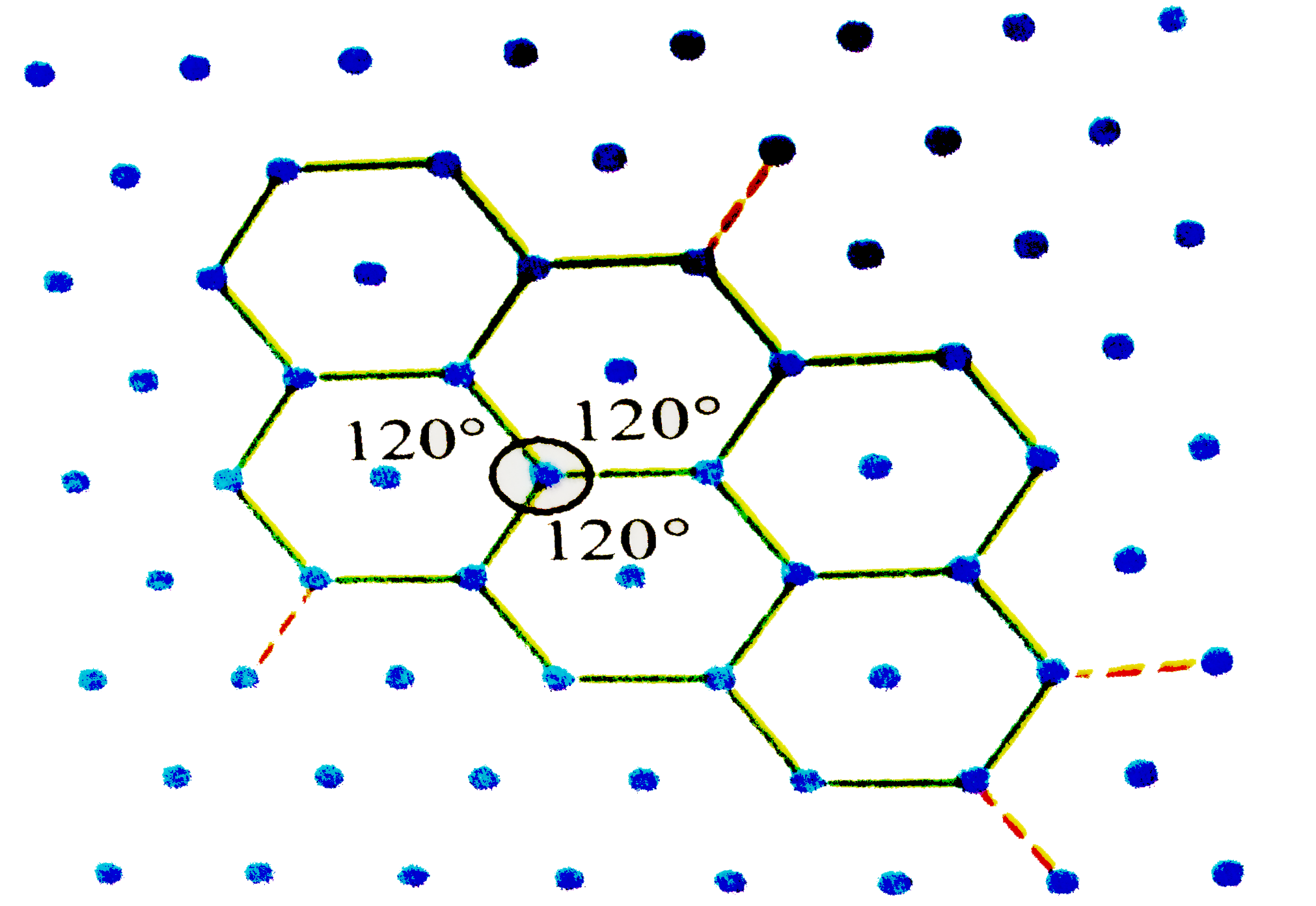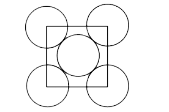If you have to create “one Schottky defect per unit cell of NaCl” by removing ions from least number of lattice points, then those suitable lattice points would be
Edge centre and body centre
Face centre and body centre
Edge centre and face centre
Body centre and corners
The correct Answer is:B
To solve the problem of creating one Schottky defect per unit cell of NaCl by removing ions from the least number of lattice points, we need to follow these steps:
1. Understanding the Structure of NaCl:
- NaCl crystallizes in a face-centered cubic (FCC) lattice structure.
- In the FCC unit cell, there are 4 Na⁺ ions and 4 Cl⁻ ions. This is because there are 8 corners (each contributing 1/8) and 6 face centers (each contributing 1/2).
2. Identifying the Number of Ions:
- Total Na⁺ ions = 4 (from 8 corners and 6 face centers)
- Total Cl⁻ ions = 4 (from 8 corners and 6 face centers)
3. Understanding Schottky Defect:
- A Schottky defect occurs when an equal number of cations and anions are missing from the lattice, maintaining the stoichiometric ratio.
- To create one Schottky defect, we need to remove one Na⁺ ion and one Cl⁻ ion.
4. Choosing Lattice Points to Remove Ions:
- The least number of lattice points would be to remove one Na⁺ ion from the body center (which is an octahedral void) and two Cl⁻ ions from the face centers.
- This is because the face centers contain Cl⁻ ions, and removing two Cl⁻ ions from the face centers will maintain the required stoichiometric ratio.
5. Calculating Remaining Ions:
- After removing 1 Na⁺ from the body center, we have:
- Remaining Na⁺ = 4 - 1 = 3
- After removing 2 Cl⁻ from the face centers, we have:
- Remaining Cl⁻ = 4 - 2 = 2
6. Checking the Stoichiometric Ratio:
- Remaining Na⁺: 3
- Remaining Cl⁻: 2
- The ratio of Na⁺ to Cl⁻ is now 3:2, which does not maintain the 1:1 ratio required for a Schottky defect.
- Therefore, we need to ensure that we remove ions in a way that keeps the ratio balanced.
7. Final Adjustment:
- To maintain the 1:1 ratio, we can remove:
- 1 Na⁺ from the body center
- 1 Cl⁻ from one of the face centers
- This gives us:
- Remaining Na⁺ = 4 - 1 = 3
- Remaining Cl⁻ = 4 - 1 = 3
- Now the ratio is 3:3 or 1:1, which is acceptable.
Conclusion:
The suitable lattice points to create one Schottky defect per unit cell of NaCl by removing ions from the least number of lattice points would be:
- Remove 1 Na⁺ from the body center.
- Remove 1 Cl⁻ from one of the face centers.
- NaCl crystallizes in a face-centered cubic (FCC) lattice structure.
- In the FCC unit cell, there are 4 Na⁺ ions and 4 Cl⁻ ions. This is because there are 8 corners (each contributing 1/8) and 6 face centers (each contributing 1/2).
- Total Na⁺ ions = 4 (from 8 corners and 6 face centers)
- Total Cl⁻ ions = 4 (from 8 corners and 6 face centers)
- A Schottky defect occurs when an equal number of cations and anions are missing from the lattice, maintaining the stoichiometric ratio.
- To create one Schottky defect, we need to remove one Na⁺ ion and one Cl⁻ ion.
- The least number of lattice points would be to remove one Na⁺ ion from the body center (which is an octahedral void) and two Cl⁻ ions from the face centers.
- This is because the face centers contain Cl⁻ ions, and removing two Cl⁻ ions from the face centers will maintain the required stoichiometric ratio.
- After removing 1 Na⁺ from the body center, we have:
- Remaining Na⁺ = 4 - 1 = 3
- After removing 2 Cl⁻ from the face centers, we have:
- Remaining Cl⁻ = 4 - 2 = 2
- Remaining Na⁺: 3
- Remaining Cl⁻: 2
- The ratio of Na⁺ to Cl⁻ is now 3:2, which does not maintain the 1:1 ratio required for a Schottky defect.
- Therefore, we need to ensure that we remove ions in a way that keeps the ratio balanced.
- To maintain the 1:1 ratio, we can remove:
- 1 Na⁺ from the body center
- 1 Cl⁻ from one of the face centers
- This gives us:
- Remaining Na⁺ = 4 - 1 = 3
- Remaining Cl⁻ = 4 - 1 = 3
- Now the ratio is 3:3 or 1:1, which is acceptable.
The suitable lattice points to create one Schottky defect per unit cell of NaCl by removing ions from the least number of lattice points would be:
- Remove 1 Na⁺ from the body center.
- Remove 1 Cl⁻ from one of the face centers.
Similar Questions
Knowledge Check
- Question 1 - Select One
The effective number of lattice points per unit cell
 A1B2C3D4
A1B2C3D4 - Question 2 - Select One
In Each unit cell of NaCl chlorine atoms are present at 14 lattice points then at how many lattice point, 'Na' will be present -
A13 Na atomsB14 Na atomsC6 Na atomsD8 Na atoms - Question 3 - Select One
Total number of lattice points in SCC, BCC and FCC unit cell are respectively :-
A2, 4 and 6B1, 2 and 4C8, 9 and 14D8, 9 and 4
An element has unit cell made up of planes as shown below:

Co-ordination number of a lattice point in the above solid is __________ .View SolutionA crystal of NaCl, which has sodium ionis and chloride ions missing from the lattice point, is solid to exhibit:
View SolutionThe number of moles of ions present in one mole of unit cells of NaCl
View SolutionDefects are basically irregularities in the arrangement of constituent particles. Broadly speaking the defects are of two types. Namely point defects and line defects.
Point defects: The irregularities or deviations from ideal arrangement around a point or an atom in the crystalline substance.
Line defects: The irregularities or deviations from ideal arrangement in entire row of lattice points.
Answer the following question.
Select the correct statements :
Frenkel defect create a vacancy defect at its original site and an interstitial defect at its new position.
Frenkel defect is also called dislocation defect
Silver halide shows Frenkel defectView SolutionDefects are basically irregularities in the arrangement of constituent particles. Broadly speaking the defects are of two types. Namely point defects and line defects.
Point defects: The irregularities or deviations from ideal arrangement around a point or an atom in the crystalline substance.
Line defects: The irregularities or deviations from ideal arrangement in entire row of lattice points.
Answer the following question.
When crystals of LiCI is heated in an atmosphere of Li (vap). it appears pink in colour because ofView Solution

